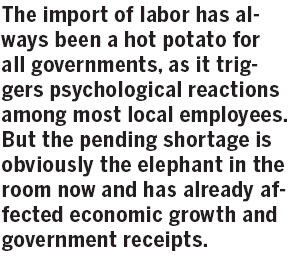Importing labor a choice?
Updated: 2013-05-04 05:54
By Eddy Li(HK Edition)
|
|||||||
The container terminal labor dispute, after more than 30 days, is still ongoing. A large number of containers have been kept too long in stock, causing supply shortages in many commodities and influencing people's normal life. As the Chinese would put it, it takes more than one cold day for a river to freeze three-feet deep. But, this dispute is a reflection of the difficulty Hong Kong is facing in the labor market - more specifically, the acute shortage of labor.
According to the Census and Statistics Department, the population in Hong Kong was 6.79 million in 2004, will be 7.39 million in 2014 and 7.89 million in 2023. The number is undeniably growing, but the percentage of labor force is estimated to be 52.1 percent, 51 percent and 46.1 percent for the respective years. Due to an aging population, the labor force actually reduces while the total population increases.

Currently, many companies in Hong Kong make every effort to produce novel and interesting recruiting gimmicks to attract applicants. For example, a new hotel provided snacks and Rubik's cubes to create a relaxed and amiable environment for waiting applicants, and the hotel also presented cookies to them after the interview.
The construction business is the harder-hit area by a labor shortage. Consider how many works are, or will be, in the process of construction: the West Island Line, the Hong Kong-Zhuhai-Macao Bridge, the new cruise terminal at Kai Tak, the West Kowloon Cultural District, the Express Rail Link, the third runway of Hong Kong International Airport, the expedited home buildings, to name a few.
Many constructing processes are already performed on the mainland and further handled in Hong Kong, such as the manufacturing of ventilation or air-conditioning ducts and the cutting of pipes. But even under those circumstances, according to professionals, some specific skilled jobs still suffer a 15 percent worker shortage, causing delays in construction work.
If the labor shortage is not properly dealt with, disputes between capital and labor will become a regular dilemma. There has been discussion about the import of laborers ,which merits in-depth discussion.
The import of labor has always been a hot potato for all governments, as it triggers psychological reactions among most local employees. But the pending shortage is obviously the elephant in the room now and has already affected economic growth and government receipts.

In Singapore, the ratio limit of local to imported labor in construction is as high as one-in-seven, i.e. there can be seven imported workers out of eight employees on a project. However, there are additional tax rules: employers have to pay extra tax for imported laborers; the lower the technology involved, the higher the tax; the tax of every migrant worker varies from 280 to 650 Singapore dollars ($227 to $527). What's more, the Singapore government approves working visas depending on an employee's educational background and monthly salary to control the low-tech labor force.
Singapore has set the rule according to its own situation, which is different from Hong Kong, so we shouldn't copy the same way. But as we can see, the Singapore government took responsibility in working out the measure to solve the shortage of labor force rather than escape reality.
When we consider the city we live in, it's sad to see the authorities' aversion to mentioning such a problem even when the truth is staring all of us in the face. I think it is high time we discussed the issue, and the focal point should be how to import labor with local laborer's rights securely protected.
The author is vice-president of the Chinese Manufacturers' Association of Hong Kong
(HK Edition 05/04/2013 page4)